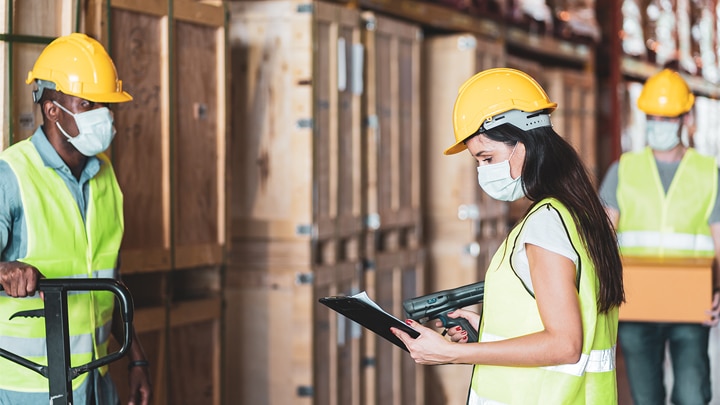
Over the past year, manufacturing companies have found themselves on the front lines of the COVID-19 pandemic. And challenges like hitches in the supply chain, tariffs, significant increases in online shopping, and mass purchase of essential goods all created upheaval throughout the industry.
But even with the promise of large-scale vaccine rollouts, it’s clear that manufacturers must take a hard look at their operations to remain successful and profitable. And that includes re-examining policies and procedures to align with a suddenly less-globalized world and a renewed focus on people – from the safety of workers to the shifting expectations and habits of consumers. Here are five manufacturing trends bubbling up as a result of COVID-19 and what they could mean for risk-management planning moving forward.
1. Re-evaluating (and shortening) supply chains
Manufacturers around the world have been re-evaluating supply chains, from the previous lean, low-cost global model to one that offers more stability. According to a study from Foley and Lardner LLP that asked more than 150 manufacturing executives about their new policies under COVID-19, 62 percent agreed that they would shift focus away from just-in-time manufacturing and toward a more stable inventory model.
Alongside shifts toward more resilient policies, many companies are shortening supply chains – and moving out of China. According to the same study by Foley, “Of the survey respondents who have operated [China], 59 percent have either already withdrawn operations, are in the process of doing so, or are considering it.” Of the respondents surveyed by Foley, 74 percent of companies are moving, or considering moving, their supply chains into the United States, 47 percent are considering a move to Mexico, and 24 percent are considering Canada.
Beyond the pandemic, ongoing tariffs have also influenced supply chains, including the decision to reduce reliance on China. With ongoing fluctuations in political policies and trade deals, moving domestic can help companies avoid large tax bills while also stabilizing product inventories and pricing for consumers.
Risk-management takeaway: whatever changes a company decides to make to its supply chain, it will continue to face a variety of potential disruptions ranging from natural disasters and pandemics to equipment breakdowns and supplier delays. Maintaining supply chain best practices, like establishing business continuity plans, understanding partner operations, prioritizing product safety, and staying on top of contracts and insurance, can help businesses minimize disruptions.
2. Adopting automation for improved safety and production
Manufacturing is an essential business, which means maintaining worker safety while continuing operations remains a key priority for businesses. Social distancing protocols and other health and safety measures significantly changed production capacity for manufacturers. And automation became a bigger priority, offering a viable solution for working more efficiently, despite new limitations under COVID-19.
In its survey on technology and manufacturing under COVID-19, Industry Week reported that many companies are using automation to meet social distancing requirements, reduce physical strain for workers, and improve efficiency. According to a survey from Hitachi Vantara, 48 percent of manufacturing respondents are already using robotics and automation to help overcome challenges presented by COVID-19, while 41 percent planned to increase their investments in these technologies. This trend is growing quickly and – with reduced injury rates and improved efficiency – is likely to stick around, even post-COVID-19.
Risk-management takeaway: investing in automation can help improve worker safety, job satisfaction, and labor productivity — all of which can also help reduce costs. To successfully implement automation into operations, a manufacturer should identify where the technology is most critically needed, make sure the right talent is in place to operate and maintain it, and re-examine the company’s risk-management plan to determine if additional coverage, training, or other key steps are needed.
3. Bypassing distributors and going direct to consumer
Disintermediation, or cutting out the middleman, is another trend of the COVID-19 era. For example, since the pandemic began, using online direct-to-consumer (DTC) channels to purchase consumer-packaged goods has grown by 50 percent.
A recent survey of 6.6 million shoppers reflects this change, with most respondents saying they now prefer purchasing directly from a brand’s site, rather than from a retailer. These changes have shifted how manufacturers are approaching their relationships with distributors. With from the previous year, many companies are choosing to bypass distributors and reduce or completely eliminate physical stores. For manufacturers, DTC models present opportunities to reduce costs, build relationships with customers, and gain a better understanding of their preferences – qualities that are increasingly important in a post-COVID-19 world.
Risk-management takeaway: while DTC models can offer several benefits, they may also introduce new risks that wholesale or retail partners would typically retain. For example, in addition to adding potential complexity to the supply chain, selling direct to consumers can also expand liability risk and introduce new cyber exposures. Manufacturers should review the end-to-end consumer experience, from ordering and delivery to customer service, to identify potential challenges and risk-management implications.
4. Improving transparency across supply chains
Communicating about supply-chain capacity is now critical, as buyers struggle to find reliable supplies of essential goods. According to Ann Marie Uetz of Foley’s Coronavirus Task Force, “Whereas, prior to the crisis, customers might request information and not get it, in the midst of the pandemic it is no longer acceptable to not show your cards or be uncommunicative with buyers.”
In addition, there is growing customer demand for detailed product information – the source, history, and path of the goods – making it even more important for manufacturers to be transparent when it comes to sourcing. This level of buyer interest will likely continue even as the economy recovers.
Risk-management takeaway: for many manufacturers, technology, like blockchain, can help answer the “what, where, and when” questions related to delivery of goods. Before adopting any new technology, a manufacturer should consider how a solution can serve the business’ specific needs, the potential risk-management challenges introduced, and the changes needed, from employee training and vendor sourcing to equipment and insurance coverage, for successful implementation.
5. Elevating focus on social responsibility
In the current environment, societal concerns like diversity, labor practices, and sustainability are taking a front seat. For many buyers, a company’s commitment to social responsibility is just as important as its financial performance and they want to engage with brands that align with their beliefs. For example, a recent survey of 1,000 consumers found that 73 percent would be just as likely or more likely to support or purchase from brands who take meaningful action to support social justice.
Risk-management takeaway: to help with transparency related to corporate governance and social good, manufacturers should not only review their own policies and practices, but also those of their partners (and their partners’ partners) across the supply chain. Establishing criteria to evaluate current and potential suppliers can help a company build relationships with those vendors with similar practices, cultures, and views. And if you do want suppliers and other vendors to follow certain guidelines, including product specifications, how materials are sourced, or safety and employment guidelines to help protect workers, consider including these in your contracts.
Embracing the new normal in manufacturing
The trends of the past year indicate a major shift in how manufacturers do business – both in terms of operations and the way they communicate with buyers. As people around the globe attempt to embrace “the new normal,” manufacturers are also adjusting their policies to thrive in a post-COVID-19 world, and many of these policies are likely to continue for the long term.
Related insights
This website is general in nature, and is provided as a courtesy to you. Information is accurate to the best of Liberty Mutual’s knowledge, but companies and individuals should not rely on it to prevent and mitigate all risks as an explanation of coverage or benefits under an insurance policy. Consult your professional advisor regarding your particular facts and circumstance. By citing external authorities or linking to other websites, Liberty Mutual is not endorsing them.



